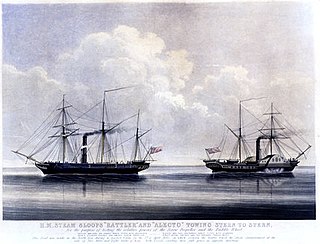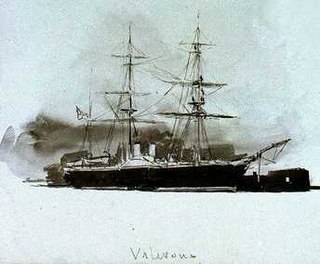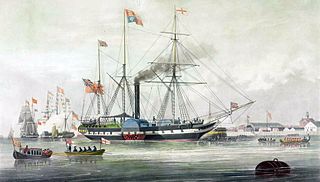Eight ships of the Royal Navy have borne the name HMS Jackal, after the predatory mammal, the jackal:

HMS Gorgon was a wooden steam paddle sloop of 6 guns, launched in 1837. In 1840 she took part in the bombardment of Acre, and in 1843 was part of the Royal Navy squadron stationed in the River Plate during the Uruguayan Civil War. She was converted to a troopship and in 1858 assisted Agamemnon in the laying of the first transatlantic telegraph cable. She was sold for breaking in 1864.

HMS Rattler was a 9-gun steam screw sloop of the Royal Navy, and one of the first British warship to be completed with screw propulsion. She was originally ordered as a paddle wheel 4-gun steam vessel from Sheerness Dockyard on 12 March 1841. She was reordered on 24 February 1842 as a propeller type 9-gun sloop from HM Royal Dockyard, Sheerness as a new vessel. Sir William Symonds had redesigned the ship as a screw propeller driven vessel.

HMS Vulture was one of three 6-gun, steam-powered Cyclops-class second-class paddle frigates built for the Royal Navy in the 1840s. She was initially deployed to the East Indies where she participated in actions against China and then played a minor role in the Crimean War of 1854–1855. The ship was sold for scrap in 1863.

HMS Valorous was one of two 16-gun, steam-powered Magicienne-class second-class paddle frigates built for the Royal Navy in the 1850s. Commissioned in 1853 she played a small role in the Crimean War of 1854–1855 and was sold for scrap in 1891.

HMS Trident was an iron paddle sloop built for the Royal Navy by Ditchburn & Mare in 1845 at Leamouth, London. She served in the Mediterranean, off West Africa and in the South Atlantic, and was broken up in 1866.

The third HMS Dauntless was a wooden-hulled steam screw frigate, launched at Portsmouth in 1847.

HMS Avenger was a wooden paddle wheel frigate of the Royal Navy launched in 1845 and wrecked with heavy loss of life in 1847.

HMS Niger was originally slated to be built as a Sampson designed sloop; however, she was ordered as a First-Class sloop with screw propulsion on 20 February 1845 to be built at Woolwich Dockyard, along the design developed by Oliver Lang and with a hull like the Basilisk designed paddle sloops. Her armament and engine were to be like the Encounter Design building at Pembroke. A second vessel (Florentia) was ordered on 26 March 1846 but after her keel was laid at Pembroke Dockyard, her construction was suspended on 6 October 1846 then cancelled three years later, on 22 May 1849. Niger She conducted important propulsion trials, finally proving the superiority of screw propulsion and served in West Africa, the Crimea, China, the East Indies and Australia. She took part in the New Zealand wars in 1860 and was sold for breaking in 1869.

HMS Salamander was one of the first paddle warships built for the Royal Navy. Initially classed simply as a steam vessel, she was re-classed as a second-class steam sloop when that categorisation was introduced on 31 May 1844. She was launched in 1832 from Sheerness Dockyard, took part in the Second Anglo-Burmese War and was broken up in 1883.

HMS Phoenix was a 6-gun steam paddle vessel of the Royal Navy, built in a dry dock at Chatham in 1832. She was reclassified as a second-class paddle sloop before being rebuilt as a 10-gun screw sloop in 1844–45. She was fitted as an Arctic storeship in 1851 and sold for breaking in 1864.

HMS Barracouta was the last paddle sloop built for the Royal Navy. She was built at Pembroke Dockyard and launched in 1851. She served in the Pacific theatre of the Crimean War, in the Second Opium War and in the Anglo-Ashanti wars. She paid off for the last time in 1877 and was broken up in 1881.

HMS Lizard was a Jackal-class second-class iron paddle gunvessel of the Royal Navy. She was built by Robert Napier and Sons at Govan to a design by William Symonds, the Surveyor of the Navy. She was launched in 1844, was damaged at the Anglo-French blockade of the Río de la Plata, performed fishery protection duties off Scotland and broken up in 1869.

HMS Bloodhound was an iron-hulled paddle gunvessel of the Royal Navy. She was built by Robert Napier and Sons at Govan, to a design drawn up by the builder. She was fitted as a tender to the paddle frigate Sampson at Portsmouth between 1849 and 1851,

HMS Magicienne was the lead ship of her class of two 16-gun, steam-powered second-class paddle frigates built for the Royal Navy in the 1850s. Commissioned in 1853 she played a small role in the Crimean War of 1854–1855 and was sold for scrap in 1866.

The Jackal-class gunvessel was a class of two second-class iron paddle gunvessels built for the Royal Navy in the mid 1840s. They served in the Mediterranean and South Atlantic, and latterly on fishery protection duties off Scotland.

The Archer-class sloops were a class of two wooden screw sloops built for the Royal Navy in the late 1840s. Both ships served during the Crimean War, Archer in the Baltic Sea, and Wasp in the Black Sea, and they both served on the overseas stations of the British Empire, as far afield as the East Indies and both North and South America. Both played an anti-slavery role off the coasts of West Africa. By 1869 they had both been broken up.
HMS Raven was a four-gun Lark-class cutter built for the Royal Navy during the 1820s. She was sold for scrap in 1859.
HMS Medina was a 2-gun Merlin-class paddle packet boat built for the Royal Navy during the 1830s. The ship remained in ordinary until she was commissioned in 1848. She was converted into a survey ship in 1856 and was broken up in March 1864.
HMS Medusa was one of three 2-gun Merlin-class paddle packet boat built for the Royal Navy during the 1830s. She was converted into a tugboat in 1861–1862 and sold for scrap in 1872.















